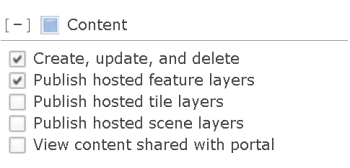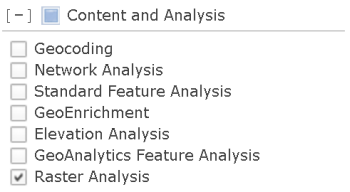ArcGIS Image Server includes distributed raster analysis and distributed image processing. ArcGIS Image Server distributed analytics can work with a single large raster dataset, such as world elevation, or a high resolution satellite image. It can also be applied to massive collections of imagery, such as the current Landsat 8 archive or the growing Sentinel-2 archive.
Raster analysis provides scalable distributed processing for large image and raster collections, including your existing GIS and imagery data. With the ArcGIS Enterprise portal, you can use built-in raster analysis tools to process and create new persisted layers, which can be made available as image and feature web layers.
The following are two examples of performing raster analysis:
- Computing vegetation coverage surface from multiple band imagery, so you can make an agricultural assessment
- Finding suitable locations to build solar power plants, using statewide elevation and land cover data
Note:
Starting with the ArcGIS Enterprise 10.7.1 release, a number of deep learning raster analysis services are introduced. These deep learning service tasks allow you to export training samples from imagery and perform image feature identification to classify pixels and detect features using existing deep learning models.In order to perform these deep learning workflows, Portal for ArcGIS and ArcGIS Server require additional configuration to install deep learning python modules. Please refer to Configure and deploy ArcGIS Enterprise for deep learning raster analytics for more details.
Access the raster analysis tools
The raster analysis tools can be used in Map Viewer, in ArcGIS Python API, ArcGIS REST API, and ArcGIS Pro.
Access the tools from Map Viewer
- Sign in to the portal as a member with the proper privileges.
In order to perform raster analysis, the minimum set of privileges needed are publishing and raster analysis:
- Content—Create, update, and delete and Publish hosted feature layers
- Content and Analysis—Raster Analysis


For more information about setting up the proper privileges, see Configure the portal to perform raster analysis .
- Click Map to open Map Viewer.
- Click Analysis and choose the Raster Analysis tools.
Note:
If you do not see the Analysis button or the Raster Analysis tab in Map Viewer, contact your portal administrator. Your portal may not be configured with ArcGIS Image Server, or you may not have privileges to run the tools. If you do not have the permissions required for the tools, they will not be visible.
Map Viewer tool overview
You can run the raster analysis tools on the following two data types:
- Imagery layers
- Feature layers
The following tables contain descriptions of the raster analysis tools. The analysis tools are arranged in categories. These categories are logical groupings and do not affect how you access or use the tools in any way.
Analyze Image
These tools derive information from imagery based on algorithms for a specific purpose such as vegetation analysis, change detection or image classification.
| Tool | Description |
|---|---|
Monitor Vegetation | This tool performs an arithmetic operation on the bands of a multiband raster layer to reveal vegetation coverage information of the study area. The output of this tool is a hosted imagery layer. |
Analyze Patterns
These tools explore spatial patterns in your data.
| Tool | Description |
|---|---|
Calculate Density | This tool creates a density map from point or line features by spreading known quantities of some phenomenon (represented as attributes of the points or lines) across the map. The result is a layer of areas classified from least dense to most dense. The output of this tool is a hosted imagery layer. |
Interpolate Points | This tool allows you to predict values at new locations based on measurements from a collection of points. The tool takes point data with values at each point and returns a raster of predicted values. The output of this tool is a hosted imagery layer and a hosted feature layer—in the form of a table. |
Analyze Terrain
These tools calculate slope, aspect, and viewshed surfaces from Digital Elevation Models (DEM).
| Tool | Description |
|---|---|
Calculate Slope | This tool creates a surface that shows the slope of the input elevation data. Slope represents the rate of change of elevation for each digital elevation model (DEM) cell. The output of this tool is a hosted imagery layer. |
Create Viewshed | This tool identifies the areas an observer can see, accounting for surface topography. The input point locations can represent either observers (such as people on the ground or lookouts in a fire tower), or observed objects (such as wind turbines, water towers, vehicles, or other people). The results define the areas that can be seen from the observer locations. The output of this tool is a hosted imagery layer. |
Derive Aspect | This tool creates an aspect map from an elevation data source. Aspect identifies the downslope direction of the maximum rate of change in value from each cell to its neighbors. Aspect can be thought of as the slope direction. The values of the output raster will be the compass direction of the aspect. The output of this tool is a hosted imagery layer. |
Watershed | This tool determines the contributing area above a set of cells in a raster. The output of this tool is a hosted imagery layer. |
Deep Learning
These tools allow you to detect specific features in an image or to classify pixels in a raster dataset using deep learning inference tools.
| Tool | Description |
|---|---|
Classify Pixels Using Deep Learning | Runs a trained deep learning model on an input raster to produce a classified raster, with each valid pixel having a class label assigned. The output of this tool is a hosted imagery layer. |
Detect Objects Using Deep Learning | Runs a trained deep learning model on an input raster to produce a feature class containing the objects it finds. The features can be bounding boxes or polygons around the objects found, or points at the centers of the objects. The output of this tool is a hosted imagery layer. |
Export Training Data For Deep Learning | Generates training sample image chips from the input imagery data with labeled vector data or classified images. The output of this service tool is the datastore string where the output image chips, labels and metadata files are going to be stored. |
Note:
At ArcGIS Enterprise 10.7.1, Export Training Data For Deep Learning tool can be used only from ArcGIS API for Python, and ArcGIS REST API. It is not available from Map Viewer or ArcGIS ProManage Data
These tools are used to manage image data, which includes clipping/masking, remapping pixel values, and converting to and from feature data.
| Tool | Description |
|---|---|
Convert Feature To Raster | This tool converts features to a raster dataset. Any feature class containing point, line, or polygon features can be converted to a raster dataset. The output of this tool is a hosted imagery layer. |
Convert Raster To Feature | This tool converts a raster to a feature dataset, as points, lines, or polygons. The output of this tool is a hosted feature layer. |
Extract Raster | This tool can clip a raster to a boundary, either to a rectangular area or to a shape you define interactively on the screen. You can clip to the extent of the area you currently have displayed on your map or by the study area defined by a polygon. The output of this tool is a hosted imagery layer. |
Remap Values | This tool allows you to change or reclassify the pixel values of the raster data. Pixels values are remapped by specifying a range of pixel values to map to an output pixel value. The output pixel value can be a valid value or a NoData value, which are pixels that do not have a known value associated with it. The output of this tool is a hosted imagery layer. |
Summarize Data
This tool allows you to use one dataset to define areas you want to summarize from the values of another dataset.
| Tool | Description |
|---|---|
Summarize Raster Within | This tool summarizes a raster based on areas (zones) defined by the first input layer. The output of this tool is a hosted imagery layer. |
Use Proximity
These tools allow you to perform analysis based on proximity, and to find optimal paths to get to a destination.
| Tool | Description |
|---|---|
Calculate Distance | This tool calculates Euclidean distance, direction, and allocation from a single source or set of sources. The output of this tool is a hosted imagery layer. |
Determine Optimum Travel Cost Network | This tool calculates the optimum cost network from a set of input regions. The output of this tool is a hosted feature layer. |
Determine Travel Cost Path As Polyline | This tool calculates the least cost polyline path between sources and known destinations. The output of this tool is a hosted feature layer. |
WebUIAccess the tools from ArcGIS Python API
ArcGIS Python API allows GIS analysts and data scientists to query, visualize, analyze, and transform their spatial data using the raster analysis tools available in their organization. To learn more about the analysis capabilities of the API, see the documentation site.
The raster analysis tools can be accessed via the raster module.
Access the tools from ArcGIS REST API
Besides the user interface clients ArcGIS Pro or Map Viewer, raster analysis services can also be accessible through the ArcGIS REST API. The Raster Analysis service tasks, based on geoprocessing tools, provide popular raster analysis tools categorized by tasks that analyze patterns, analyze terrain, manage data, summarize data, process raster data using parallel processing and classify data.
The Raster function editor is exposed in Map Viewer through the Enterprise portal. The Raster function editor is a visual programming interface for building imagery and raster analysis processing chains. The workflows can be saved as raster function templates (RFTs), which can automate your image analyses and processes. You can create and modify RFTs in the function editor panel. The Raster function editor contains a large gallery of raster functions. These raster functions can be combined into raster function processing chains—called a Raster Function Template (RFT)—using the visual programming tools. The RFTs can be tested, edited, saved and shared with other members of your enterprise.
In addition to the Raster Analysis service tasks above, distributed raster analysis can be performed utilizing individual raster functions, or raster functions combined in raster function chains, using the Generate Raster analysis tool. This tool takes a well-defined raster function JSON object as input, and perform analysis based on the function definition. The user can either directly use the system built in raster function we support today or their own custom raster models. See Raster function objects for the substantial list of available functions for distributed raster analysis processing and storage of distributed output.
Create imagery layers
Use Create imagery layers to create imagery layers optimized for use in the raster analysis tools, REST APIs and Python APIs above. Created image layers can be written to a raster store and published as image services. The imagery data you use as input can come from a local folder or from a data store. The output can be hosted imagery layers or imagery layers that reference the registered data source. Imagery layers that reference the registered data source are not managed by enterprise. When you delete a referenced imagery layer, the data will not be deleted from data store.
Access the tools from ArcGIS Pro
Raster Analysis tools can be accessed from the portal from ArcGIS Pro. See the help documentation in ArcGIS Pro for more details.